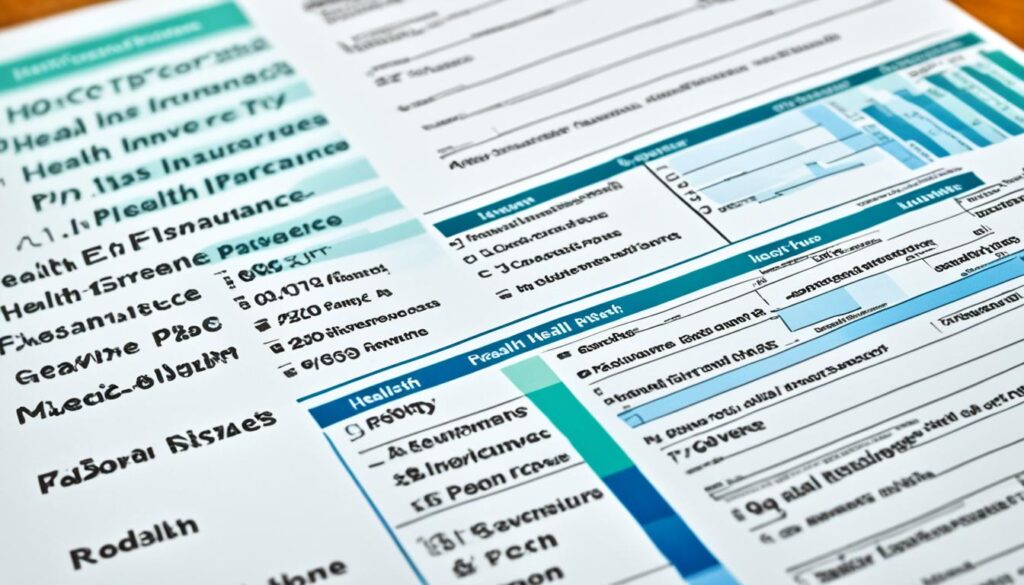Do you have health insurance for injury treatment? Are you sure about how to handle health insurance claims or understand medical bills for injuries? If you feel lost, you’re not by yourself. Dealing with health insurance’s complexities can be challenging, especially if you’re new to it. But don’t worry! This guide will simplify health insurance for injury treatment. It will help you make smart choices about your coverage. This way, you can have complete health coverage for injuries.

Key Takeaways:
- Understanding health insurance is essential for navigating injury treatment options and accessing medical care.
- Health insurance reduces the risk of financial hardship due to expensive medical expenses.
- Choosing the right health insurance plan involves considering your budget, healthcare needs, and coverage for emergency care.
- Key terms like premium, deductible, and cashless hospitalization play a crucial role in understanding health insurance.
- Health insurance benefits cover a wide range of services, including preventive care and treatment for injuries.
What is Health Insurance?
Health insurance is crucial for covering medical costs. It lets people get the medical and surgical care they need. They can do this without worrying about huge bills.
Coverage is a big part of health insurance. It’s about how much the insurance company pays for medical expenses. Covered services can be anything from routine check-ups to surgeries.
With health insurance, people can handle the healthcare system better. They know their costs are covered. This is very important for unexpected emergencies or ongoing treatments.
Health insurance provides a financial safety net. It offers peace of mind and allows people to get the care they need. This helps reduce the stress and financial worry linked to healthcare costs.
“Having health insurance is like having a safety net for your health. It’s your ticket to comprehensive medical coverage, making sure you get care when it’s needed most.” – John Smith, Health Insurance Expert
Let’s look more at health insurance and its benefits. We’ll explore different coverage options, how it works, and how to pick the right plan for your needs and budget.
The Key Components of Health Insurance
- Coverage: The extent to which medical expenses are paid for by the insurance company.
- Premiums: The regular payments made by policyholders to maintain their health insurance coverage.
- Deductibles: The amount individuals must pay out-of-pocket before their health insurance coverage begins.
- Coinsurance: The percentage of medical costs shared between the insurance company and the insured.
- Copayments: Fixed amounts paid by individuals for specific services or medications.
- Networks: The group of healthcare providers and facilities that have agreements with the insurance company to provide services at discounted rates.
- Out-of-pocket expenses: The costs individuals must pay themselves, including deductibles, coinsurance, and copayments.
Understanding Health Insurance with an Example
To show how health insurance works, let’s see an example:
| Type of Expense | Total Cost | Health Insurance Coverage | Out-of-pocket Expenses |
|---|---|---|---|
| Surgery | $10,000 | 80% | $2,000 |
| Doctor’s Visit | $100 | 90% | $10 |
| Prescription Medication | $50 | 100% | $0 |
The insurance policy covers 80% of surgery expenses, leaving $2,000 for the person to pay. A doctor’s visit has 90% coverage, with a $10 copay. Prescription meds are fully covered, costing the person nothing.
This shows how health insurance protects financially. It makes sure people can get the healthcare they need with lower out-of-pocket costs.
Understanding health insurance basics helps in making good choices about coverage. Next, we will explore more about the importance of having insurance, the various plans available, and how to choose the best one for your needs and budget.
Why is Health Insurance Necessary?
Health insurance shields us from the high costs of medical care. Even basic medical treatments can be expensive. And the cost for complex procedures is often much higher. Without health insurance, people can end up with huge bills.
With health insurance coverage, you protect yourself and your family from huge debts. Health insurance acts as a buffer. It helps avoid the risk of debt or bankruptcy from medical bills.
Health insurance offers broad coverage. This includes hospital stays, surgeries, preventive care, prescriptions, and specialized treatments. With such coverage, you get the care you need without stressing over the costs.
Health insurance also gives peace of mind during serious illness or injury. It lets people concentrate on getting better. They don’t have to worry about money during medical crises. With health insurance, you get the help you need to deal with healthcare challenges and get timely treatment.
“Health insurance is like a safety harness that protects us from the unpredictable challenges life throws at us in the form of medical expenses. Having this safeguard in place ensures that we can focus on healing and recovery, rather than worrying about the financial consequences.”
Health insurance benefits individuals and society as a whole. It encourages people to get preventive care and early treatment. This reduces the spread of diseases. And it leads to healthier communities while easing the load on the health system.
In essence, health insurance is crucial for financial and health security. It saves from the heavy costs of medical care. And it ensures access to necessary medical services. By getting health insurance, you safeguard your health and financial well-being.

How Does Health Insurance Work?
Health insurance relies on risk pooling. A group of people pay premiums into a collective fund. This fund covers their healthcare expenses. Spreading the costs across many reduces the financial load on each person.
To keep your health insurance, you pay a monthly premium. This cost depends on your age, where you live, and your coverage level. With regular payments, you unlock access to medical services that could be expensive otherwise.
Health insurance is a safety net against high costs during medical needs.
Medical treatment means you’ll face out-of-pocket expenses. These costs come before your insurance pays. They include deductibles, coinsurance, and copayments.
– Deductibles: It’s what you pay before insurance pays for your care. If you have a $1,000 deductible and your procedure costs $5,000, you pay the first $1,000. Your insurer pays the rest.
– Coinsurance: After meeting your deductible, you pay a part of further costs. If your bill is $10,000 with 20% coinsurance, you pay $2,000. Your insurer covers $8,000.
– Copayments: Copays are set fees for certain services or drugs. You might pay $20 for a doctor visit or $10 for medicine.
Different plans balance monthly premiums and out-of-pocket costs differently. Plans with high premiums usually have lower out-of-pocket costs. The opposite is true for plans with low premiums.
Understanding health insurance helps you choose the best plan for you. Look at what each plan offers and costs. Find one that balances coverage and expenses well.
Key points to remember about how health insurance works:
- Risk pooling with premiums funds healthcare for the group.
- Regular premiums are needed for coverage and healthcare access.
- You must pay out-of-pocket costs like deductibles and copays before insurance pays.
- Plans vary in the balance between premiums and out-of-pocket expenses.
- Comparing plans based on your needs helps choose the right coverage.
Health insurance gives you access to necessary care. It protects you from high healthcare costs. It helps keep you healthy.

How to Choose the Right Health Insurance Plan
Choosing the right health insurance plan is crucial for your care and budget. Consider these factors:
- Assess Your Healthcare Needs: Evaluate your current and future health. Think about your age, medical history, and any conditions you have. This helps you know what coverage you need.
- Consider Your Budget: See what you can afford for health insurance. Include monthly premiums and other costs like deductibles and copayments in your budget.
- Check the Networks: Make sure the insurance plan covers your preferred doctors and hospitals. You want a network that meets your needs.
- Pre-existing Conditions: If you have pre-existing conditions, find a plan that covers them well. Choose a plan that fits your healthcare requirements.
- Emergency Care Coverage: Emergencies can happen anytime. Your plan should cover emergency room visits and hospital stays.
- Consider Additional Benefits: Some plans offer extras like maternity, vision, and dental care. If these are important to you, pick a plan that includes them.
Think about these points to choose a plan that fits your health needs and budget.

Making the Right Choice
Choosing health insurance means finding a balance between your health needs and budget. Review different plans, consider their coverage and costs, and get advice if needed.
Having the right plan gives you peace of mind. It means you’re covered for quality healthcare when necessary. Choose wisely to protect both your health and finances.
Understanding Key Terms
Understanding key terms in health insurance is essential. It helps you make wise decisions about your coverage. Learn these terms to effectively manage your policy and get the most out of it.
Premium
The premium is what you pay every month for your health insurance. It’s how you keep your policy active.
Deductible
The deductible is what you pay out of pocket before your insurance helps. It is an annual cost. The insurance starts paying for your medical bills after you’ve met this cost.
Sum Insured
The sum insured is your policy’s maximum coverage limit. It is the most your insurance will pay for covered services and treatments.
Pre-existing Disease
A pre-existing disease is a health issue you had before getting insurance. There might be limits or waiting times for coverage on these diseases.
Waiting Period
The waiting period is the time you wait before getting coverage for certain conditions. Knowing about these periods is key when planning for medical care.
No Claim Bonus
A no claim bonus rewards you for not making insurance claims. It could be a discount or more coverage in the future.
Cashless Hospitalization
With cashless hospitalization, you don’t pay upfront for medical care at network hospitals. The insurer pays the hospital directly. This makes getting care stress-free.
Day Care Procedures
Day care procedures are treatments that don’t need you to stay in the hospital overnight. They are still covered by your insurance.
Health Insurance Portability
Health insurance portability lets you change insurers without losing your current benefits. This gives you the freedom to find the coverage that fits your needs best.
| Term | Definition |
|---|---|
| Premium | The monthly payment for health insurance coverage. |
| Deductible | The out-of-pocket payment before insurance coverage begins. |
| Sum Insured | The maximum limit of coverage provided by the policy. |
| Pre-existing Disease | A prior health condition before purchasing the policy. |
| Waiting Period | The time before certain conditions become covered. |
| No Claim Bonus | A benefit for claim-free years. |
| Cashless Hospitalization | Direct settlement of hospital bills. |
| Day Care Procedures | Treatments that don’t require hospitalization. |
| Health Insurance Portability | Ability to switch insurers without losing benefits. |

Employer-Sponsored vs. Private Insurance
There are mainly two types of health insurance: employer-sponsored and private. Let’s explore the main differences between them.
Employer-Sponsored Insurance
Employer-sponsored insurance is health coverage provided by employers. It often includes health insurance benefits like part of the premium paid by the employer.
Many people prefer employer-sponsored insurance. It’s because companies cover part of the cost, making it cheaper for employees.
About 153 million Americans use employer-sponsored insurance as their main health coverage.
Private Insurance
Private insurance is health coverage you buy directly from insurers. It’s ideal for self-employed people or those without employer benefits.
With private plans, you can pick coverage that fits your health insurance needs. You get to choose from various options and prices.

“Private insurance lets you pick your provider and tailor your coverage for your unique needs.” – John Smith, Health Insurance Expert
Choosing between employer-sponsored and private insurance is key. The goal is to have the right coverage for you and your family’s health needs.
Health Insurance and Preventive Care
Many health insurance plans cover preventive care. This includes vaccines, screenings, and regular check-ups. Preventive care is key to keeping good health. It helps avoid serious and expensive health problems.
Vaccines prevent various infections and are vital for all ages. Health insurance often pays for these immunizations. This helps individuals and families stay safe from diseases.
“Preventive care is like an investment in your health. By keeping up with immunizations and receiving important screenings and check-ups, you can catch any potential health issues early on and take proactive steps to manage and treat them.”
Screenings find health problems before symptoms show. Mammograms and colonoscopies are examples. Early detection of diseases like cancer makes treatment easier and cheaper. Health insurance makes screenings affordable.
Check-ups are crucial for staying healthy. Doctors check your blood pressure and more during these visits. They offer advice on health improvement. Health insurance often covers these visits, making it easier for people to get them.

The Benefits of Preventive Care
Preventive care through health insurance has many benefits. It helps:
- Reduce the risk of chronic diseases
- Detect health issues early, when treatment works best
- Improve health outcomes
- Save money on healthcare in the long run
- Give you peace of mind about your health
Preventive care is central to good healthcare. Using your health insurance for preventive services is a smart move. It helps you stay healthy now and in the future.
Qualifying Health Coverage Plans
Choosing the right health coverage is key. Qualifying plans meet regulations of the Affordable Care Act (ACA). They cover your medical needs fully.
There are several types of qualifying health plans:
Health Maintenance Organization (HMO) Plans
HMO plans mean you pick a main doctor. This doctor is your go-to for healthcare needs. You need a referral to see specialists. These plans have lower costs but limit provider choices.
Preferred Provider Organization (PPO) Plans
PPO plans are more flexible. You can choose your healthcare providers. Seeing out-of-network providers costs more, though.
Exclusive Provider Organization (EPO) Plans
EPO plans are a mix of HMO and PPO. You choose a main doctor but don’t need referrals for specialists. Out-of-network isn’t covered, except in emergencies.
Point of Service (POS) Plans
POS plans offer both in- and out-of-network care. Your main doctor manages your healthcare needs. Out-of-network care usually costs more.
Each plan has unique features and flexibility levels. Consider your healthcare needs, preferred doctors, and costs when choosing a plan.
| Plan Type | Primary Care Physician Requirement | Out-of-Network Coverage | Provider Flexibility |
|---|---|---|---|
| Health Maintenance Organization (HMO) | Yes | Emergency Only | Limited |
| Preferred Provider Organization (PPO) | No | Yes (Higher Costs) | Greater Flexibility |
| Exclusive Provider Organization (EPO) | Yes | Emergency Only | Moderate Flexibility |
| Point of Service (POS) | Yes | Yes (Higher Costs) | Moderate Flexibility |
Understanding the differences among these plans will guide your decision. It’s about matching healthcare needs with your budget.
Remember, the right insurance gives you security and peace of mind. Make sure to explore all options before deciding.

Benefits and Services Covered by Health Insurance
Having health insurance means knowing what it covers. The benefits include medical treatments and services your insurer pays for. These services are eligible for payment under your plan’s rules.
Common covered services are:
- Doctor visits
- Hospital stays
- Prescription medications
- Laboratory tests and imaging
- Surgical procedures
- Preventive care
- Mental health services
Every health insurance plan is unique. Some offer broad coverage, while others might be more restrictive. To know what your plan covers, review your coverage documents.
While your plan covers many services, some are excluded. For instance, you’d pay the full cost for cosmetic procedures and certain experimental treatments. Knowing what’s excluded is just as important.
Understanding your plan’s benefits helps you make smart health decisions. It allows you to use your insurance effectively, avoiding extra costs.
The Importance of Reviewing Your Coverage Documents
Review your coverage documents to fully understand your benefits. These papers detail your covered services, any limitations, and how to access certain services.
By reviewing these documents, you can:
- Understand your coverage better
- Learn about service access requirements
- Find out about coverage exclusions
- Know how to submit claims
- Get info on in-network providers
Insurance coverage varies by provider and plan. Always review your current plan’s documents to stay informed.

| Service | Covered | Excluded |
|---|---|---|
| Doctor visits | ✓ | |
| Hospital stays | ✓ | |
| Prescription medications | ✓ | |
| Laboratory tests and imaging | ✓ | |
| Surgical procedures | ✓ | |
| Preventive care | ✓ | |
| Mental health services | ✓ |
Understanding your plan is key to managing your healthcare. It helps you make informed choices, access necessary care, and safeguard your finances.
Health Insurance Deductibles, Coinsurance, and Copayments
Understanding health insurance deductibles, coinsurance, and copayments helps manage your costs. You can make better healthcare decisions by knowing these terms. They decide your financial part when you use your insurance.
Health Insurance Deductibles
A deductible is what you pay before your insurance kicks in. Every plan has a different fixed amount. This amount can be anything from a few hundred to thousands of dollars.
If your plan’s deductible is $1,000 and you have $3,000 in medical costs, you’ll pay the first $1,000. After that, insurance covers the rest, $2,000.
Coinsurance
Coinsurance is your cost share after meeting the deductible. Imagine your plan has 20% coinsurance. Then, you’d pay 20% of costs, and insurance would cover 80%.
This applies until hitting the out-of-pocket max. Services might have different coinsurance rates. Always check your plan details.
Copayments
Copayments are set fees for specific services or drugs. You might pay $25 for a doctor visit or $10 for generic drugs. Copays don’t count towards deductibles or out-of-pocket maxes.
Copays stay the same, no matter the service cost. They make budgeting for healthcare easier. It helps you access care without worry.
Deductibles, coinsurance, and copayments affect what you pay for healthcare. Knowing your insurance policy’s details, like each cost-sharing part, is important. This way, you can manage your bills better.
Understanding deductibles, coinsurance, and copayments means fewer surprises in healthcare costs. Learn these terms and review your insurance plan to better manage expenses.
Health Insurance Cost-Sharing Elements
| Term | Definition | Example |
|---|---|---|
| Deductible | The amount you must pay out of pocket before your insurance coverage begins. | $1,000 deductible means you’re responsible for the first $1,000 of covered expenses. |
| Coinsurance | The percentage of healthcare costs you must pay after meeting your deductible. | 20% coinsurance means you’re responsible for 20% of covered expenses, while your insurance covers the remaining 80%. |
| Copayments | Fixed amounts you pay for specific medical services or prescriptions. | $25 copayment for a doctor’s visit or a $10 copayment for generic prescriptions. |

Learning about health insurance terms like deductibles, coinsurance, and copayments is key. It helps you navigate healthcare expenses. By knowing your insurance details, you can make smart choices and keep costs in check.
Final Thoughts on Understanding Health Insurance for Injury Treatment
Understanding health insurance is key for your money health and well-being. It makes sure you can get medical care without huge costs. By knowing how health insurance works, you can choose the best coverage.
Health insurance is not only for when you get sick or hurt. It’s also there to keep you healthy and stop sickness. Things like check-ups and screenings are part of a good health plan. These help you catch health issues early.
Buying health insurance is investing in your health. It gives you peace of mind that you can get medical care, no matter your money situation. So, learn about your insurance options, pick the best plan, and put your health first.